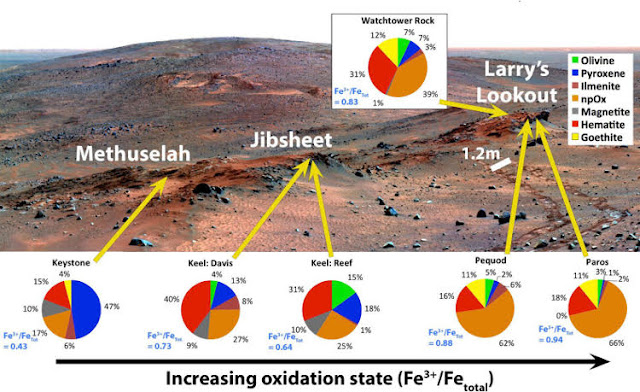And Spirit, the Little Rover that Could
(November 2, 2015) Boulder,
CO, USA - While Mars doesn't have much in the way of Earth-like weather, it
does evidently share one kind of weird meteorology: acid fog.
Planetary scientist Shoshanna Cole has pieced together a
compelling story about how acidic vapors may have eaten at the rocks in a
100-acre area on Husband Hill in the Columbia Hills of Gusev Crater on Mars.
She used a variety of data gathered by multiple instruments on the 2003 Mars
Exploration Rover Spirit to tease out information from exposures of the ancient
bedrock. She will be presenting her work on Monday, Nov. 2, in Baltimore,
Maryland, at the annual meeting of the Geological Society of America.
The work focused on the 'Watchtower Class' outcrops on
Cumberland Ridge and the Husband Hill summit, said Cole, who is an assistant
professor at Ithaca College and began studying the area for her Ph.D. thesis at
Cornell University.
"The special thing about Watchtower Class is that it's
very widespread and we see it in different locations. As far as we can tell,
it's part of the ground there," which means that these rocks record
environments that existed on Mars billions of years ago.
By combining data from previous studies of the area on Mars,
Cole saw some intriguing patterns emerge. Spirit examined Watchtower Class
rocks at a dozen locations spanning about 200 meters along Cumberland Ridge and
the Husband Hill summit. The chemical composition of these rocks, as determined
by Spirit's Alpha Proton X-ray Spectrometer (APXS), is the same, but the rocks
looked different to all of the other instruments.
Across Cumberland Ridge -- which is about 1/3 the size of a
football field -- the Mössbauer Spectrometer showed there was a surprisingly
wide range in the proportion of oxidized iron to total iron, as if something
had reacted with the iron in these rocks to different degrees. This iron
oxidation state ranges from 0.43 to 0.94 across a span of only 30 meters.
Meanwhile, data from both the Mössbauer Spectrometer and the Miniature Thermal
Emission Spectrometer (Mini-TES) showed that the minerals within the rocks
changed and lost their structure, becoming less crystalline and more amorphous.
And these trends match the size of small bumps, which Cole calls
agglomerations, seen in Pancam and Microscopic Imager pictures of the rocks.

